AMD’s Radeon HD 6870 & 6850: Renewing Competition in the Mid-Range Market
by Ryan Smith on October 21, 2010 10:08 PM ESTKicking things off as always is Crysis: Warhead, still the toughest game in our benchmark suite. Even 2 years since the release of the original Crysis, “but can it run Crysis?” is still an important question, and the answer continues to be “no.” One of these years we’ll actually be able to run it with full Enthusiast settings…
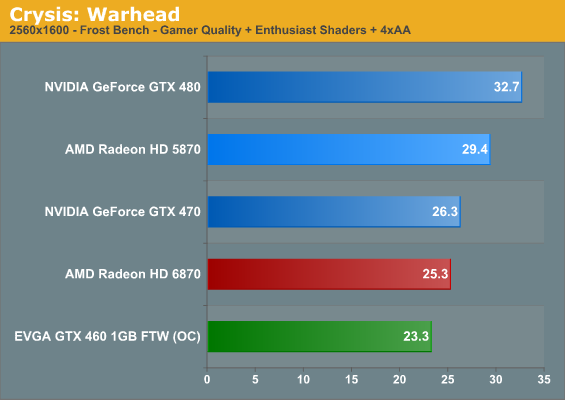
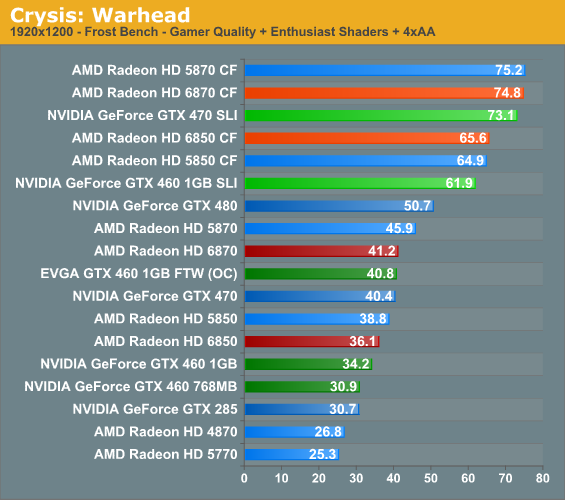
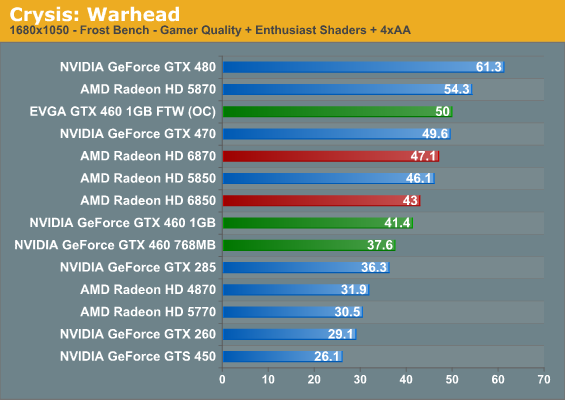
For reasons we’ve yet to determine, Crysis continues to do a very good job serving as an overall barometer for video card performance. Much of what we see here will show up later, including the order that cards fall in.
As we’ve been expecting, the 6800 series cannot keep up with the 5800 series – Barts is still a “rebalanced” Cypress after all. The performance gap isn’t too severe, and it certainly couldn’t justify 5870 prices at today’s prices, but the 6870 and 6850 definitely aren’t perfect replacements for their 5800 series counterparts.
Focusing on 1920x1200, we have a 3-way race between the GTX 470, EVGA GTX 460, and the 6870. The 6870 comes out ahead, with the EVGA and then the GTX 470 bringing up the pack at under a frame behind. Meanwhile near the 6850 is the GTX 460 1GB, and it’s 2fps behind; while even farther down the line is the GTX 460 768MB, which officially is only $10 cheaper than the 6850 and yet it’s well behind the pack. As we’ll see, the 6850 will quickly assert itself as the GTX 460 1GB’s peer when it comes to performance.
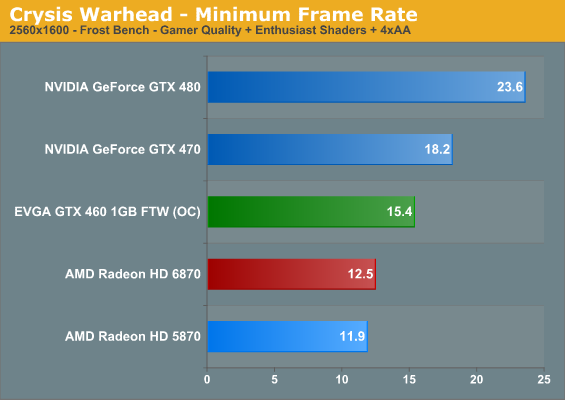
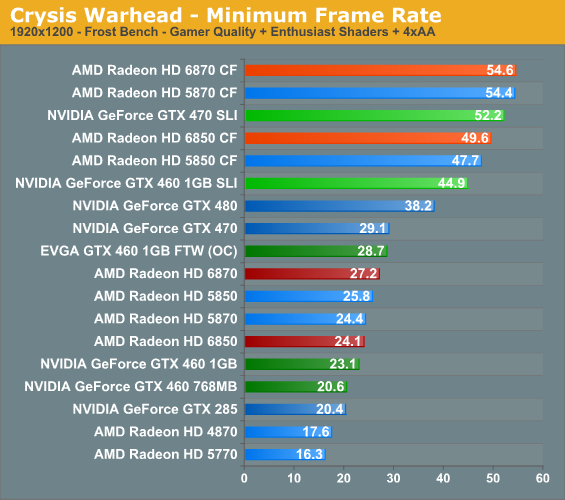
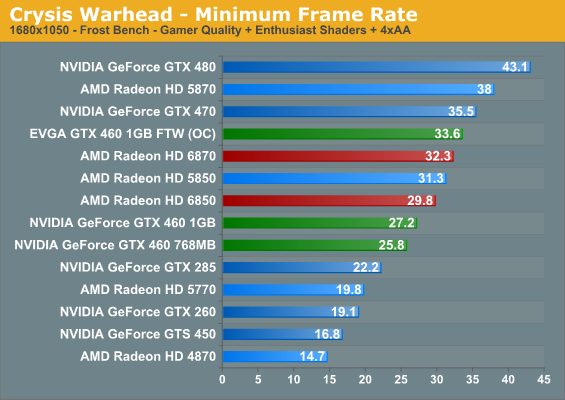
Meanwhile taking a quick look at Crossfire performance we see an interesting trend: the 6800 series cards are much closer to their 5800 series counterparts than they are in single card mode. Here the 6850CF even manages to top the 5850CF, an act that nearly defies logic. This is something we’ll have to keep an eye on in later results.
Moving on to our minimums, the picture changes slightly in NVIDIA’s favor. The 6870 drops to the bottom of its pack, while the 6850’s lead narrows versus both GTX 460 cards. Meanwhile in CF mode now both 6800 series cards top their 5800 series counterparts. Crysis’ minimum framerate has always been a bit brutal to AMD cards due to how AMD’s drivers manage their memory, a problem compounded by Crossfire mode. Perhaps something has changed?










197 Comments
View All Comments
Finally - Friday, October 22, 2010 - link
Did you have a look at the games market lately? Noticed all those shabby console ports? There is no progress because the graphics power of an XBOX or PS3 is exactly the same as it has been when they were introduced.Then again, who wants to play dumbed-down console games, made by illiterates for illiterates running on antique hardware which severely limits innovation in the graphics sector?
jimhsu - Friday, October 22, 2010 - link
"I know the 4890 is a pig (loud, noisy, power hungry) compared to the cards here"And hence your point. Essentially, major COMPUTER manufacturers (not just video card makers) simply are less concerned about maximum performance anymore -- for 95% of the population, what we have now is "good enough", and for the remaining 5%, getting more of the cheap stuff is also "good enough" (HPC builders, SLI/CrossFire, etc). Instead, people look at things like "is this quiet" (heat production, fans) or "what does this mean for my bottom line" (power consumption, replacability). The age of the monolithic "fast chip" is over.
Jamahl - Friday, October 22, 2010 - link
AMD naming the cards the 6800 series or Anandtech changing their policy of not reviewing overclocked cards.spigzone - Saturday, October 23, 2010 - link
AMD renaming their cards = more confusingAnandtech 'changing' their policy = more inexplicable.
softdrinkviking - Friday, October 22, 2010 - link
i join the throngs of disgruntled consumers that object to the new naming convention of the 6800 series.it's silly and stupid, and you should be ashamed of your collective AMD selves.
spigzone - Saturday, October 23, 2010 - link
I didn't like it either ... until I saw the release prices ...Then I didn't much care anymore.
gorg_graggel - Friday, October 22, 2010 - link
why the heck didn't they just call them 6850 and 6530? according to the numbers those are the the true internal competitors...that would also fit with the premise that a next-gen card with the same naming conventions is at least a bit faster...
the upcoming 6950 and 6970 cards could accordingly be named 6870 and 6890 respectively...
and the next 2-chip variant could have the 69xx namespace for itself as it clearly wouldn't be justified to append an x2 to it, due to the same reasons the 5000 dual-chip cards don't do this...
because of different chips? john doe doesn't know about such distinctions and just cares about performance (compared to older generations) when upgrading.
he's just confused why the 6870 is slower than a 5870 and the guy who knows more about the tech behind it is pissed, because he has to explain to him why the names are not analogous to performance and why it's not kept consistent at least for a few generations...
the explanations amd has given about this is not satisfying and gives me the impression that they deliberately want to confuse customers...however i can't think of a logical "why"...
jonup - Friday, October 22, 2010 - link
To answer your question, Because that makes too much sense!Donkey2008 - Friday, October 22, 2010 - link
I agree 100%. The new naming scheme is misleading and it seems like 6750 and 6770 would have been much more accurate IMO. From AMD releases over the last several years, the performance of nex-gen 2nd tier cards are ~ equal to the previous top tier cards. This is the first time AMD has strayed from their naming scheme in a long time and it has all the makings of a marketing dept telling the engineers what to call their cards.Like to pointed out, 95% of consumers (the ones who waddle into Best Buy and tell someone at the Geek Squad counter to "install a gaming card") won't know the difference. Most of these average consumers will believe that a 6870 is a much better card performance-wise then the previous generation 5870, so they will see the price and think it is a steal. AMD is playing the numbers game with uneducated consumers ("higher numbers are better, right?") and it is sort of disappointing IMO. I expect more from them as a psuedo-fanboy (I am a current of owner of a 4850 and (2) 4890)
I am still anxious to see what the 69xx has to offer, but some of the excitement of the entire 6xxx series launch has faded because of the new naming scheme. I just don't like marketing games and being played. Tech people are not only sharp, but HIGHLY biased and any deviation from outright perfection usually gets punished (i.e. Microsoft Vista, iPhone 4 antenna, Nvidia GT 250, etc etc). AMD should have known better.
gorg_graggel - Friday, October 22, 2010 - link
hmmm well, on second thought it could make more sense in the future as the new scheme reorganized the naming to fit more to the performance categories...if they would have been named 6750/6770 their would be riots, because amd dared to raise the prices in the midrange segment, as the author of the article already said i think, which would be even worse...
in the past amd changed strategies of how big and fast chips are a few times, but the naming didn't...they just didn't have single chips that deserved a name in the x900-range...
so now that the cayman chip is in the 300w size amd changed its sweet-spot only strategy to a more standard strategy again with low-end, midrange, performance and high-end cards and the new naming does fit perfectly here...at least i have this impression...
so it maybe confusing now, but depending on how future products turn out it will make more sense again...